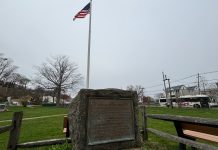By Jay Cook |
SANDY HOOK – Since Super Storm Sandy made landfall and ravaged the East Coast in 2012, federal and state agencies have been busy crafting future storm mitigation plans for the New York/New Jersey harbor.
Earlier this month, the United States Army Corps of Engineers (USACE) announced six options to protect communities inside that 2,150-plus-square-mile area from any future violent storms.
But local environmentalists seeking to keep New Jersey’s coastline free of any major infrastructure have been quick to sink the most ambitious proposals, especially the one calling for a 5-mile-long sea gate reaching from the tip of Sandy Hook to Breezy Point, New York.
“I just can’t imagine it,” said American Littoral Society executive director Tim Dillingham, who is based on Sandy Hook. “It would be a sad day if they walled off this beautiful ocean that we’re lucky enough to be next to.”
Representatives from the USACE held five meetings this month with residents and stakeholders in New York City and Newark to detail the findings from a coastal storm risk management study to determine where upgrades can be made. The City of New York, the New York Department of Environmental Conservation and the New Jersey Department of Environmental Protection (NJDEP) are partners in the study.
“Historically, the New York harbor area and the Hudson River and its tributaries have been victims of violent storms,” said Michael Embrich, a USACE New York District spokesman. “We’re looking at ways to reduce flood risk for the surrounding communities there.”
But the one alternative that’s spooked environmentalists the most is that retractable sea gate proposed to span the harbor between Sandy Hook and Breezy Point, two low-lying shore hotspots that are both part of the Gateway National Recreation Area.
Embrich said this alternative would provide a gate to open and close depending on storm events. He said it would have some type of foundation, but that material is still to be determined. Natural and nonstructural improvements are proposed to shorelines extending to the west to Far Rockaway in New York and as far south as Long Branch in New Jersey.
But that option doesn’t sit well with Greg Remaud, executive director of NY/NJ Baykeeper. While it may serve as an outer shield for New York City, it could evolve into an environmental nightmare on either end by reducing tidal flow.
“That’s what brings oxygen into the system, it’s what allows fish to migrate through the waterways, it brings nutrients in and flushes out the harbors,” Remaud said. “If you’re limiting that tidal flow that brings life to the estuary, it’s really making them become stagnant waterways that collect contaminants with low oxygen.”
Dillingham said it also comes down to a matter of sacrifice.
“Who are you asking to sacrifice themselves for the benefit of those communities on the inside of the wall?” he asked.
In addition to the sea gate proposal, the USACE suggested multiple other options. Here’s a look at what’s proposed:
- Leave the 900-plus miles of shoreline as it is. There are currently seven USACE completed or ongoing projects in both states.
- A total of five sea gates would be built in and around greater New York City to limit intense tides if a storm were to hit: The Arthur Kill barrier between Perth Amboy and Staten Island; the Verrazano-Narrows barrier spanning Staten Island and Brooklyn; the Jamaica Bay barrier connecting Brooklyn and Queens; a Pelham Bay barrier in the Bronx; and the Throgs Neck barrier linking to the Bronx and Queens.
- Barriers in Jamaica Bay, Arthur Kill, Kill Van Kull, Gowanus Canal, Newtown Creek and Pelham Bay would be built. Significant shoreline protections would be added to Jamaica Bay and farther up the Hudson River as well as into East Harlem.
- Ditch the Arthur Kill and Kill Van Kull barrier to construct a Hackensack River barrier reaching with protected shoreline extensions to Jersey City and Kearny.
- The sixth option would plan for no sea gates or barriers, just some added shielding to the Upper Hudson River on either side of the Holland Tunnel, in East Harlem, Newtown Creek and Gowanus Canal.
These are all just proposals, Embrich noted. The USACE will be accepting public comment through Aug. 20 and then will craft a narrowed-down draft report in late fall highlighting two alternatives.
“All of them might be feasible and environmentally acceptable, or none of them,” Embrich said.
“Nothing is set in stone,” he added.
This article was first published in the July 19 – 26, 2018 print edition of The Two River Times.














